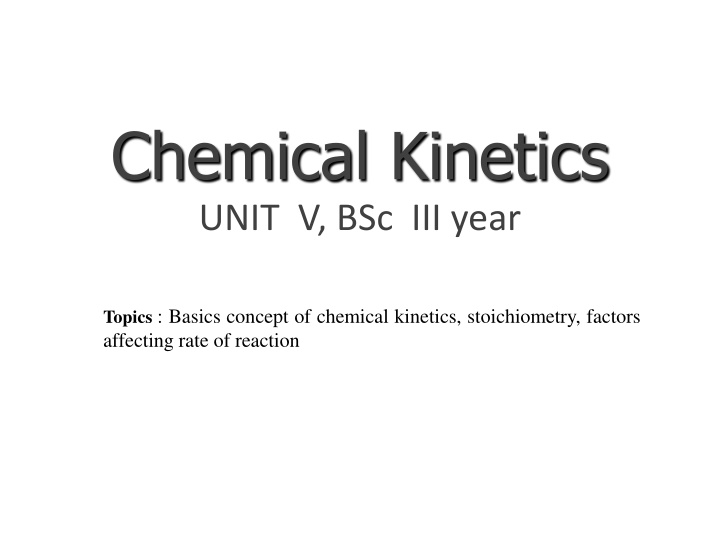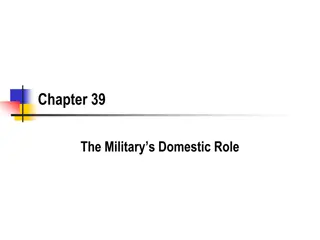
Chemical Kinetics: BSc III Year
Explore the fundamentals of chemical kinetics, stoichiometry, and factors influencing reaction rates in BSc III year curriculum. Learn about reaction rates, rate laws, and more in this in-depth study of reaction processes.
Download Presentation

Please find below an Image/Link to download the presentation.
The content on the website is provided AS IS for your information and personal use only. It may not be sold, licensed, or shared on other websites without obtaining consent from the author. If you encounter any issues during the download, it is possible that the publisher has removed the file from their server.
You are allowed to download the files provided on this website for personal or commercial use, subject to the condition that they are used lawfully. All files are the property of their respective owners.
The content on the website is provided AS IS for your information and personal use only. It may not be sold, licensed, or shared on other websites without obtaining consent from the author.
E N D
Presentation Transcript
Chemical Kinetics UNIT V, BSc III year Topics : Basics concept of chemical kinetics, stoichiometry, factors affecting rate of reaction
Chemical Kinetics Kinetics how fast does a reaction proceed? Thermodynamics does a reaction take place? Reaction speed: measured by the change in concentration with time. Important factors which affect rates of reactions: reactant concentration temperature action of catalysts surface area pressure of gaseous reactants or products
Kinetics Studies the rate at which a chemical process occurs. Besides information about the speed at which reactions occur, kinetics also sheds light on the reaction mechanism (exactly how the reaction occurs).
Outline: Kinetics Reaction Rates How we measure rates. How the rate depends on amounts of reactants. How to calculate amount left or time to reach a given amount. How long it takes to react 50% of reactants. How rate constant changes with temperature. Link between rate and molecular scale processes. Rate Laws Integrated Rate Laws Half-life Arrhenius Equation Mechanisms
Reaction Rate B there are two ways of measuring rate: For the reaction A (1) the speed at which the reactants disappear (2) the speed at which the products appear Reversible reactions: as products accumulates, they can begin to turn back into reactants. Early on the rate will depend on only the amount of reactants present. We want to measure the reactants as soon as they are mixed. A general way of measuring the rate of the reaction is in terms of change in concentration per unit time Instantaneous rate = [A]/ t limits to d[A]/dt Most Common Units Rate = M/s Where Molarity (M) = moles/Liter
Chemical Kinetics Reaction rate is the change in the concentration of a reactant or a product with time (M/s). A B [A] t [B] t [A] = change in concentration of A over time period t rate = - [B] = change in concentration of B over time period t rate = Because [A] decreases with time, [A] is negative.
Reaction Rates and Stoichiometry To generalize, for the reaction aA + bB cC + dD Reactants (decrease) Products (increase)
Heres another way of looking at reaction rates 2N2O5(g) 4NO2(g) + O2(g) Notice that for every 1 mole of O2that appears, 4 x as many moles of NO2 will also appear. In the meantime, twice as many moles of N2O5 will be disappearing as moles of O2 forming. However, the same reaction cannot have 3 different rates In stead, we write the rate of the reaction as follows: Reaction Rate = [N2O5]/ t = [NO2]/ t = [O2]/ t (i.e., rate of change in concentration divided by respective stoichiometric coefficient)
Factors Affecting Reaction Rate Constants
Factors that Affect the Reaction Rate Constant 1. Temperature:At higher temperatures, reactant molecules have more kinetic energy, move faster, and collide more often and with greater energy Collision Theory: When two chemicals react, their molecules have to collide with each other (in a particular orientation) with sufficient energy for the reaction to take place. Kinetic Theory: Increasing temperature means the molecules move faster. 2. Concentrations of reactants As the concentration of reactants increases, so does the likelihood that reactant molecules will collide. 3. Catalysts Speed up reactions by lowering activation energy 4. Surface area of a solid reactant More area for reactants to be in contact 5. Pressure of gaseous reactants or products Increased number of collisions






















